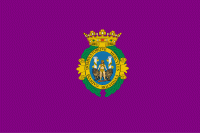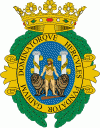Cadiz
 |
 |
Cádiz, one of the oldest continuously inhabited cities in Western Europe, was founded by the Phoenicians. In the 18th century, the Port in the Bay of Cádiz consolidated as the main harbor of mainland Spain, enjoying the virtual monopoly of trade with the Americas until 1778. It is also the site of the University of Cádiz.
Situated on a narrow slice of land surrounded by the sea‚ Cádiz is, in most respects, a typically Andalusian city with well-preserved historical landmarks. The older part of Cádiz, within the remnants of the city walls, is commonly referred to as the Old Town (Spanish: Casco Antiguo). It is characterized by the antiquity of its various quarters (barrios), among them El Pópulo, La Viña, and Santa María, which present a marked contrast to the newer areas of town. While the Old City's street plan consists of narrow winding alleys connecting large plazas, newer areas of Cádiz typically have wide avenues and more modern buildings. In addition, the city is dotted with numerous parks where exotic plants flourish, including giant trees allegedly brought to Spain by Columbus from the New World.
Numismatic inscriptions in the Phoenician language record that the Phoenicians knew the site as a Gadir or Agadir, meaning 'wall', 'compound', or (by metonymy) 'stronghold'. Borrowed by the Berber languages, this became the agadir (Tamazight: 'wall'; Shilha: 'fortified granary') common in North African place names, such as that of the Moroccan city of Agadir. The Carthaginians continued to use this name and all subsequent names have derived from it.
Attic Greek sources hellenized Gadir as tà Gádeira (τὰ Γάδειρα), which is neuter plural. Herodotus, using Ionic Greek, transcribed it a little differently, as Gḗdeira (Γήδειρα). Rarely, as in Stephanus of Byzantium's notes on the writings of Eratosthenes, is the name given in the feminine singular form as hè Gadeíra (ἡ Γαδείρα).
In Latin, the city was known as Gādēs and its Roman colony as Augusta Urbs Iulia Gaditana ("The August City of Julia of Cádiz"). In Arabic, the Latin name became Qādis (قادس), from which the Spanish Cádiz derives. The Spanish demonym for people and things from Cádiz is gaditano.
In English, the name is pronounced variously. When the accent is on the second syllable, it is usually pronounced but, when the accent is on the first syllable, it may be pronounced as, and similar, typically in American English. In Spanish, the accent is always, as according to the spelling, on the first syllable but, while the usual pronunciation in Spain is, the local dialect says , or even instead.
Map - Cadiz
Map
Country - Spain
 |
 |
| Flag of Spain | |
Anatomically modern humans first arrived in the Iberian Peninsula around 42,000 years ago. The ancient Iberian and Celtic tribes, along with other pre-Roman peoples, dwelled the territory maintaining contacts with foreign Mediterranean cultures. The Roman conquest and colonization of the peninsula (Hispania) ensued, bringing the Romanization of the population. Receding of Western Roman imperial authority ushered in the migration of different non-Roman peoples from Central and Northern Europe with the Visigoths as the dominant power in the peninsula by the fifth century. In the early eighth century, most of the peninsula was conquered by the Umayyad Caliphate, and during early Islamic rule, Al-Andalus became a dominant peninsular power centered in Córdoba. Several Christian kingdoms emerged in Northern Iberia, chief among them León, Castile, Aragon, Portugal, and Navarre made an intermittent southward military expansion, known as Reconquista, repelling the Islamic rule in Iberia, which culminated with the Christian seizure of the Emirate of Granada in 1492. Jews and Muslims were forced to choose between conversion to Catholicism or expulsion, and eventually the converts were expelled through different royal decrees.
Currency / Language
| ISO | Currency | Symbol | Significant figures |
|---|---|---|---|
| EUR | Euro | € | 2 |
| ISO | Language |
|---|---|
| EU | Basque language |
| CA | Catalan language |
| GL | Galician language |
| OC | Occitan language |
| ES | Spanish language |















